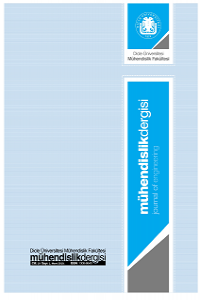Abstract
Dokusal özellikler mamografi görüntülerini sınıflandırmada yaygın olarak kullanılmaktadır. Bu çalışma, mamografi görüntülerini sınıflandırmada birinci derece ve ikinci derece dokusal özelliklerin etkisini incelemeyi amaçlamaktadır. Bu amaçla öncelikle bilgisayar destekli teşhis (BDT) sistemi tasarlanmıştır. Bilgisayar destekli teşhis sistemi temel olarak, teşhis doğruluğunu artırmayı ve desteklemeyi amaçlamaktadır. Tasarlanan sistem ön işleme, özellik çıkarımı ve sınıflandırma olarak üç adımdan oluşmaktadır. Ön işleme adımında öncelikle gürültü yok edilmiştir. Sonra pektoral kas temizlenmiş ve görüntü iyileştirme gerçekleştirilmiştir. Özellik çıkarımı aşamasında iyileştirilmiş mamogram görüntülerinden birinci derece ve ikinci derece dokusal özellikler hesaplanmıştır. Son aşamada, k en yakın komşuluk (k-EYK) algoritması, destek vektör makineleri (DVM) ve Lineer Diskriminant Analizi (LDA) yöntemleriyle mamografi görüntüleri normal ve anormal olarak sınıflandırılmıştır. Sınıflandırıcı açısından bakıldığında, DVM yönteminin k-EYK ve LDA sınıflandırıcılarına göre daha iyi bir performans sergilediği görülmektedir. LDA için %77.63, k-EYK için %82.89 ve DVM için %85.53 doğruluk ile mamografi sınıflandırılması gerçekleştirilmiştir. Her bir özellik grubu ve sınıflandırıcı için elde edilen sınıflandırma sonuçları karşılaştırılmıştır. İkinci derece dokusal özelliklerin sınıflandırma başarımını artırdığı gözlemlenmiştir.
References
- Abe, S., (2010). Support Vector Machines for Pattern Classification, 486, Springer.
- Chen, D. R., Huang, Y. L., ve Lin, S. H., (2011). Computer-aided diagnosis with textural features for breast lesions in sonograms. Computerized Medical Imaging and Graphics, 35,3, 220-226.
- El-Naqa, I., Yang, Y., Wernick, M. N., Galatsanos, N. P., ve Nishikawa, R. M., (2002). A support vector machine approach for detection of microcalcifications. IEEE Transactions on Medical İmaging, 21, 12, 1552-1563.
- Ganesan, K., Acharya, U. R., Chua, K. C., Min, L. C., ve Abraham, K. T., (2013). Pectoral muscle segmentation: a review. Computer Methods and Programs in Biomedicine, 110,1, 48-57.
- Gonzalez, R. C. vee Woods, R. E., (Z. Telatar, H. Tora, H. Arı, and A. Kalaycıoğlu), Sayısal Görüntü İşleme. Ankara: Palme Yayıncılık, 2014.
- Han, J., Kamber, M. Ve Pei, J., (2006). Data Mining. 703, Morgan Kaufmann, USA.
- Haralick, R. M., & Shanmugam, K. ve Dinstain, I., (1973). Textural features for image classification. IEEE Transactions on Systems, Man, and Cybernetics, SMC-3, 6, 610-621.
- Li, Y., Chen, H., Yang, Y., ve Yang, N., (2013). Pectoral muscle segmentation in mammograms based on homogenous texture and intensity deviation. Pattern Recognition, 46,3, 681-691.
- Mitchell, T. M., (1997). Machine learning, 432, McGraw-Hill Education, USA.
- Mustra, M., Grgic, M., ve Rangayyan, R. M., (2016). Review of recent advances in segmentation of the breast boundary and the pectoral muscle in mammograms. Medical & Biological Engineering & Computing, 54,7, 1003-1024.
- Pak, F., Kanan, H. R., ve Alikhassi, A., (2015). Breast cancer detection and classification in digital mammography based on Non-Subsampled Contourlet Transform (NSCT) and Super Resolution. Computer Methods and Programs in Biomedicine, 122,2, 89-107.
- Sahiner, B., Chan, H. P., Petrick, N., Wei, D., Helvie, M. A., Adler, D. D., ve Goodsitt, M. M., (1996). Classification of mass and normal breast tissue: a convolution neural network classifier with spatial domain and texture images. IEEE Transactions on Medical Imaging, 15,5, 598-610.
- Saltanat, N., Hossain, M. A., ve Alam, M. S., (2010). An efficient pixel value based mapping scheme to delineate pectoral muscle from mammograms. IEEE Fifth International Conference on Bio-Inspired Computing: Theories and Applications (BIC-TA), 1510-1517.
- Sreedevi, S., ve Sherly, E., (2015). A novel approach for removal of pectoral muscles in digital mammogram. Procedia Computer Science, 46, 1724-1731.
- Suckling, J., Parker, J., Dance, D.R., Astley, S., Hutt, I., Boggis, C. R. M., Ricketts, I., Stamatakis, E., Cerneaz, N., Kok, S.L., Taylor, P., Betal, D., ve Savage, J., (1994). The mammographic image analysis society digital mammogram database. Exerpta Medica. International Congress Series 1069, 375-378.
- Vapnik, V. N., (1998), Statistical Learning Theory,736, Wiley-Interscience Publication.
- Wei, D., Chan, H.P., Helvie, M.A., Sahiner, B., Petrick, N., Adler, D.D., ve G. M.M., (1995). Classification of mass and normal breast tissue on digital mammograms: multiresolution texture analysis. Medical Physics, 22, 1501-1513.
- Zheng, J. ve Xue, N., (2009) Advances in Pattern Recognition, 365, Springer.
- Zheng, Y., Keller, B. M., Ray, S., Wang, Y., Conant, E. F., Gee, J. C., ve Kontos, D., (2015). Parenchymal texture analysis in digital mammography: a fully automated pipeline for breast cancer risk assessment. Medical physics, 42, 7, 4149-4160.
Details
| Primary Language | Turkish |
|---|---|
| Journal Section | Research Article |
| Authors | |
| Publication Date | March 15, 2019 |
| Submission Date | March 9, 2018 |
| Published in Issue | Year 2019 Volume: 10 Issue: 1 |

